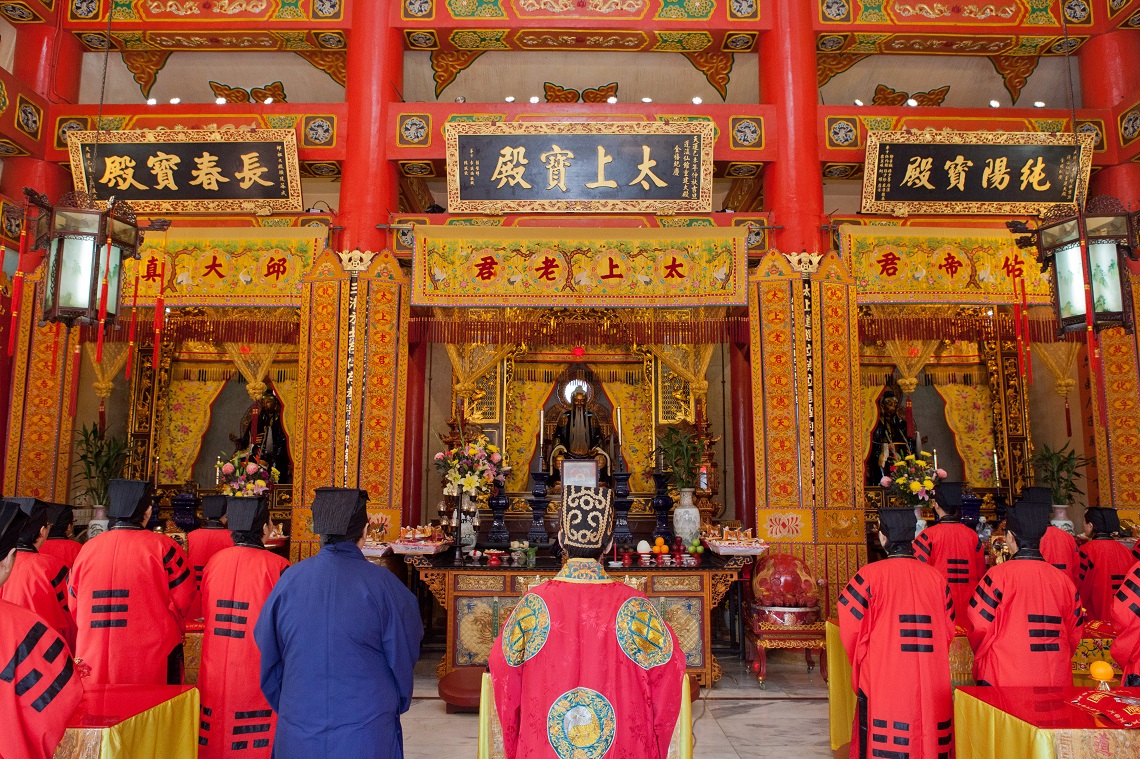
Introductory Video of Quanzhen Temples Taoist Ritual Music
Characteristics and Transmission of Lingnan Scripture Chanting
Historical Background
Daoist beliefs and rituals in Hong Kong originated mainly from the Pearl River Delta region of Guangdong. The two main schools are the Orthodox Unity tradition (Zhengyi) and the Complete Perfection tradition (Quanzhen). The Quanzhen School is a general term covering all groups belonging to this tradition, including Po Tho Tong(1921), Fung Ying Seen Koon (1929), Tung Seen Tan (1938), Wun Chuen Sin Kwoon (1944), Ching Chung Koon (1950) and Yuen Yuen Hok Yuen (1953), all founded by immigrant believers from Guangdong from the 1920’s to the 1950’s. Although their religious lineages (creed and heritage) may differ, they nearly all worship at patriarch Lü Chunyang, one of the “Five patriarchs of Quanzhen”, and acknowledge their identity under the “Quanzhen School”.
Daoist ceremonies contain both still and dynamic elements: the former include the layout and decoration of the altar, ceremonial garb and headdress, texts and scriptures; the latter refer to the “singing, chanting and gestures” by the ceremonial priests. They read aloud or chant the scriptures to a prescribed rhythm and tone, at times accompanied by music. This “vocal” and “instrumental” music used in Daoist rituals is generally referred to as Tones for Chanting (jing yun) by Daoists, and “Daoist music” by non-Daoists. This “vocal” medium is generally believed to have originated from the work Yunzhong Yinsong Xinke Zhijie (415) by Daoist priest Kou Qianzhi (365 – 448) of Mount Song of the Northern Wei period. Judging from its form and structure, this music medium has evolved from ancient Chinese court and sacrificial music with the later injection of ethnic, folk and Buddhist characteristics.
Since the preservation and perpetuation of Daoist rituals in Hong Kong are carried out mainly between a few senior Daoist masters, the ritualistic music now used in Daoist temples in Hong Kong are basically the same. In the past sixty odd years, well-known liturgy experts such as He Zhanling from Xiqiao Mountain of Nanhai, Hou Baoyuan of Ching Chung Koon, and Deng Jiuyi have all studied Daoist scripture chanting and proliferated liturgy in Hong Kong. While its lineage can be traced to Guangdong, the ritual music of the Hong Kong Quanzhen School tradition has evolved into a kind of Daoist music with Hong Kong characteristics under the influence of Cantonese opera and its singing style, Cantonese tunes, and other religious music genres such as Confucian and Buddhist music. Currently Daoist temples in all parts of Hong Kong have professional liturgical teams that perform Daoist rituals and music.
Features of Daoist Ritual Music
In general, the Daoist rituals of the Hong Kong Quanzhen School can be divided into invocations for blessings (qingjiao) and requiem services (youjiao). They include Chao Ke – worshipping the gods; Chan Ke – repentance before the gods; Qi Fu Fa Shi – prayer rituals requesting blessings and boons; Du Wang Fa Shi – ceremony of the salvation of the dead; and Daoists’ daily “morning and evening rites”. These ceremonies are usually held on Daoist festivals and birthdays of deities. For example, on the 19th day of the first month of the lunar calendar, rituals are performed to celebrate the birthday of school founder Qiu Changchun.
The scripture chanters that partake in the ceremony each have their own respective roles at the altar: they are the High Priest (gaogong fashi) (chief), Chief Cantor (dujiang fashi)(second), Inspector of Fasts (jianzhai fashi) (third), altar attendants and casual attendants. During the chanting and singing, the chief and second masters take the lead and set the pitch and tempo, while the second and third masters beat the woodblock (muyu) and stone chime (qing) to control the rhythm of the music. Liturgical music can take the four forms of “reciting”, “chanting”, “intoning” and “singing”. Some Tones for Chanting incorporate all four features. The jing and jiao masters play the musical instruments, mainly as accompaniment for the chanting and singing, but they also play the drum, the small cymbals, the horizontal flute and the suona as preludes to the ceremony or as interludes.
Apart from the chanting, the instrumental music is also the distinctive and significant part of Hong Kong Daoist ritual music. It will be performed during the beginning session, and the ritual processes without chanting. This position is undertaken by the scripture chanters or the occupational musicians (jiaoshi).




